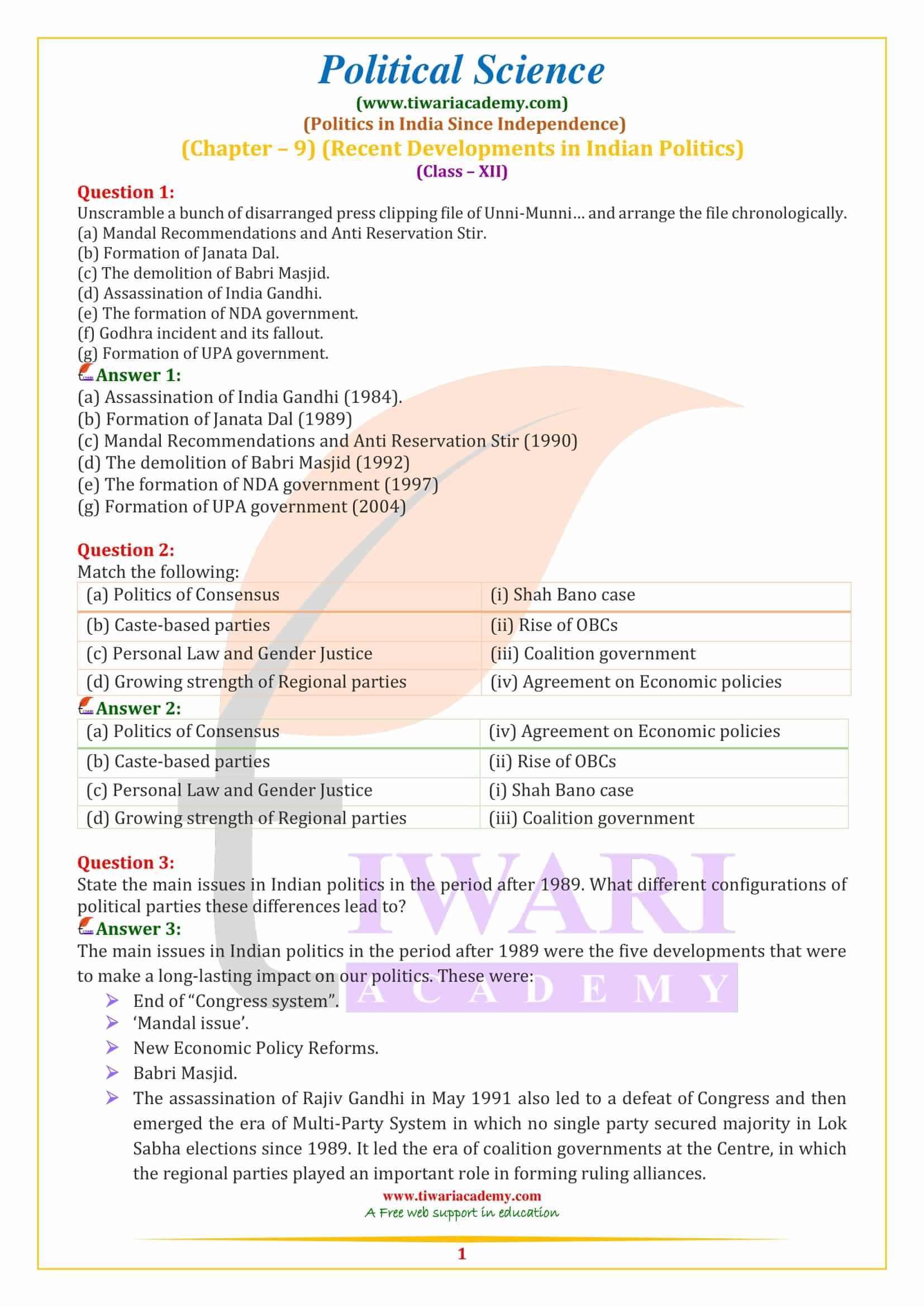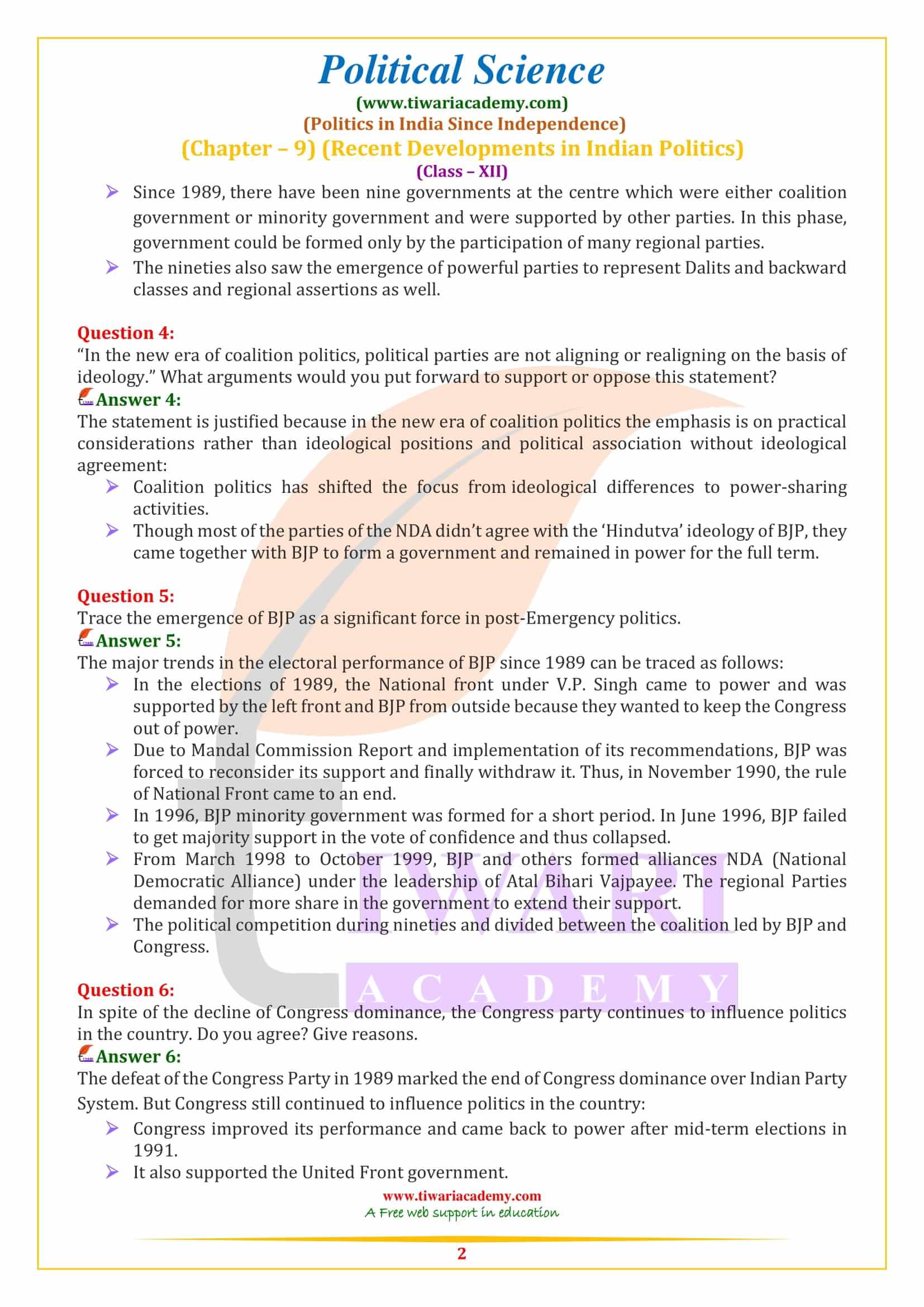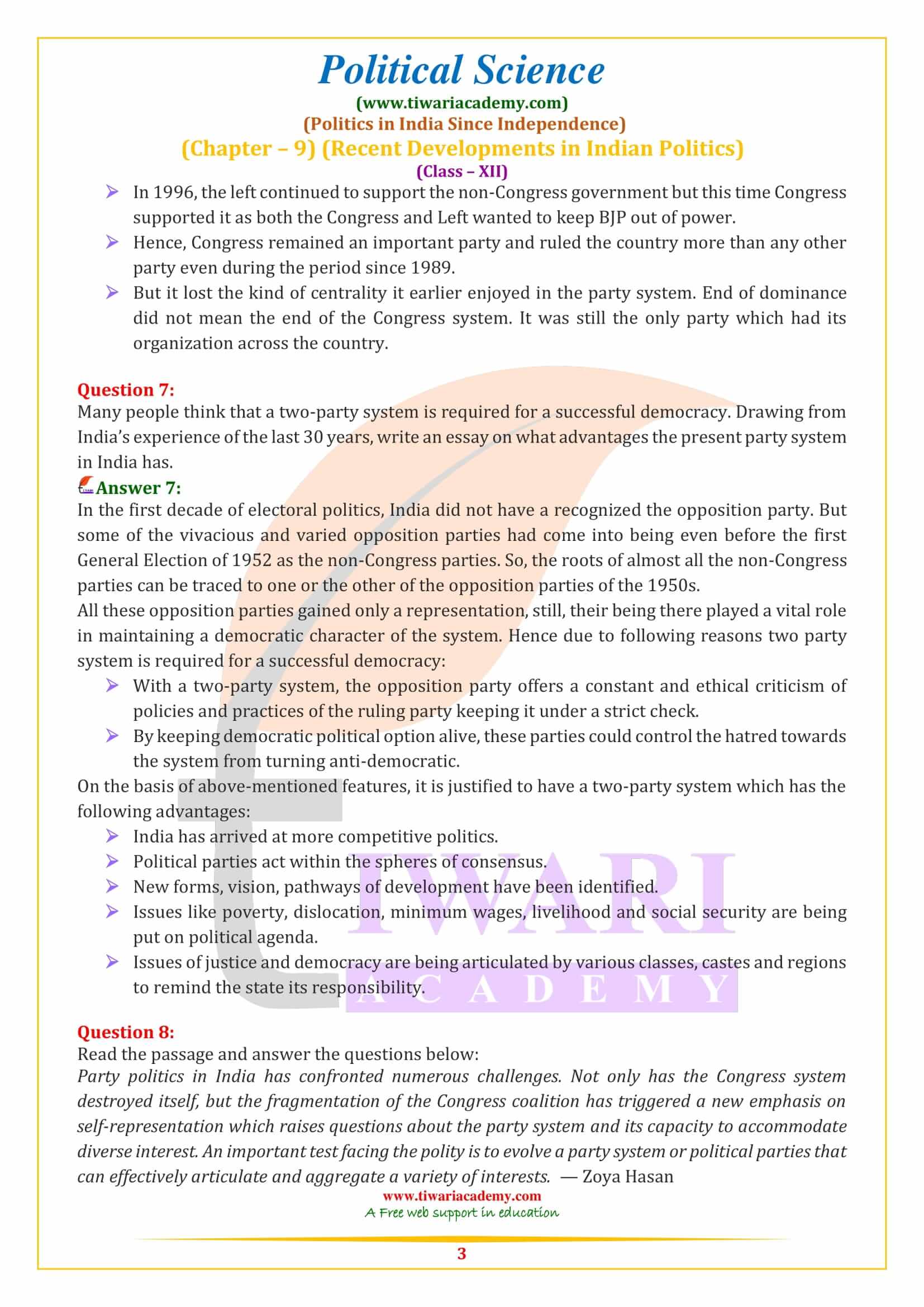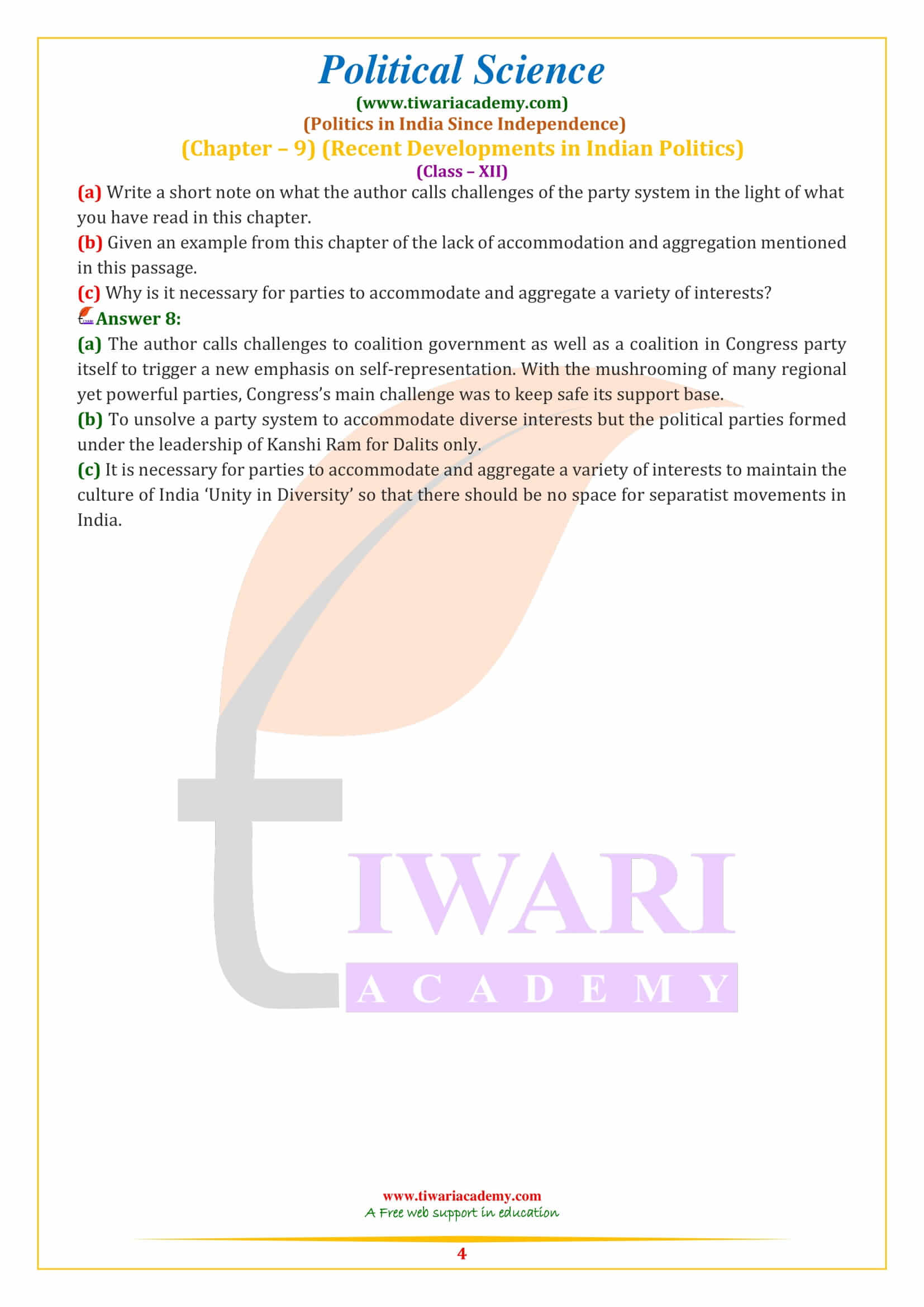NCERT Solutions for Class 12 Political Science Part 2 Chapter 9 Recent Developments in Indian Politics in Hindi and English medium updated for new academic session 2025-26. Hindi medium Video related to Class 12 Political Science Part 2 Politics in India since Independence chapter 9 is also given with complete explanation.
NCERT Solutions for Class 12 Political Science Chapter 9
Class 12 Political Science Chapter 9 Recent Developments in Indian Politics
State the main issues in Indian politics in the period after 1989. What different configurations of political parties these differences lead to?
The main issues in Indian politics in the period after 1989 were the five developments that were to make a long-lasting impact on our politics. These were:
- End of “Congress system”.
- ‘Mandal issue’.
- New Economic Policy Reforms.
- Babri Masjid.
- The assassination of Rajiv Gandhi in May 1991 also led to a defeat of Congress and then emerged the era of Multi-Party System in which no single party secured majority in Lok Sabha elections since 1989. It led the era of coalition governments at the Centre, in which the regional parties played an important role in forming ruling alliances.
- Since 1989, there have been nine governments at the centre which were either coalition government or minority government and were supported by other parties. In this phase, government could be formed only by the participation of many regional parties.
- The nineties also saw the emergence of powerful parties to represent Dalits and backward classes and regional assertions as well.
In the new era of coalition politics, political parties are not aligning or realigning on the basis of ideology. What arguments would you put forward to support or oppose this statement?
The statement is justified because in the new era of coalition politics the emphasis is on practical considerations rather than ideological positions and political association without ideological agreement:
- Coalition politics has shifted the focus from ideological differences to power-sharing activities.
- Though most of the parties of the NDA didn’t agree with the ‘Hindutva’ ideology of BJP, they came together with BJP to form a government and remained in power for the full term.
Trace the emergence of BJP as a significant force in post-Emergency politics.
The major trends in the electoral performance of BJP since 1989 can be traced as follows:
- In the elections of 1989, the National front under V.P. Singh came to power and was supported by the left front and BJP from outside because they wanted to keep the Congress out of power.
- Due to Mandal Commission Report and implementation of its recommendations, BJP was forced to reconsider its support and finally withdraw it. Thus, in November 1990, the rule of National Front came to an end.
- In 1996, BJP minority government was formed for a short period. In June 1996, BJP failed to get majority support in the vote of confidence and thus collapsed.
- From March 1998 to October 1999, BJP and others formed alliances NDA (National Democratic Alliance) under the leadership of Atal Bihari Vajpayee. The regional Parties demanded for more share in the government to extend their support.
- The political competition during nineties and divided between the coalition led by BJP and Congress.
In spite of the decline of Congress dominance, the Congress party continues to influence politics in the country. Do you agree? Give reasons.
The defeat of the Congress Party in 1989 marked the end of Congress dominance over Indian Party System. But Congress still continued to influence politics in the country:
- Congress improved its performance and came back to power after mid-term elections in 1991.
- It also supported the United Front government.
- In 1996, the left continued to support the non-Congress government but this time Congress supported it as both the Congress and Left wanted to keep BJP out of power.
- Hence, Congress remained an important party and ruled the country more than any other party even during the period since 1989.
- But it lost the kind of centrality it earlier enjoyed in the party system. End of dominance did not mean the end of the Congress system. It was still the only party which had its organization across the country.
Many people think that a two-party system is required for a successful democracy. Drawing from India’s experience of the last 30 years, write an essay on what advantages the present party system in India has.
In the first decade of electoral politics, India did not have a recognized the opposition party. But some of the vivacious and varied opposition parties had come into being even before the first General Election of 1952 as the non-Congress parties. So, the roots of almost all the non-Congress parties can be traced to one or the other of the opposition parties of the 1950s.
All these opposition parties gained only a representation, still, their being there played a vital role in maintaining a democratic character of the system. Hence due to following reasons two party system is required for a successful democracy:
1. With a two-party system, the opposition party offers a constant and ethical criticism of policies and practices of the ruling party keeping it under a strict check.
2. By keeping democratic political option alive, these parties could control the hatred towards the system from turning anti-democratic.
On the basis of above-mentioned features, it is justified to have a two-party system which has the following advantages:
- India has arrived at more competitive politics.
- Political parties act within the spheres of consensus.
- New forms, vision, pathways of development have been identified.
- Issues like poverty, dislocation, minimum wages, livelihood and social security are being put on political agenda.
- Issues of justice and democracy are being articulated by various classes, castes and regions to remind the state its responsibility.
Read the passage and answer the questions below:
Party politics in India has confronted numerous challenges. Not only has the Congress system destroyed itself, but the fragmentation of the Congress coalition has triggered a new emphasis on self-representation which raises questions about the party system and its capacity to accommodate diverse interest. An important test facing the polity is to evolve a party system or political parties that can effectively articulate and aggregate a variety of interests. — Zoya Hasan
Write a short note on what the author calls challenges of the party system in the light of what you have read in this chapter.
The author calls challenges to coalition government as well as a coalition in Congress party itself to trigger a new emphasis on self-representation. With the mushrooming of many regional yet powerful parties, Congress’s main challenge was to keep safe its support base.
Given an example from this chapter of the lack of accommodation and aggregation mentioned in this passage.
To unsolve a party system to accommodate diverse interests but the political parties formed under the leadership of Kanshi Ram for Dalits only.
Why is it necessary for parties to accommodate and aggregate a variety of interests?
It is necessary for parties to accommodate and aggregate a variety of interests to maintain the culture of India ‘Unity in Diversity’ so that there should be no space for separatist movements in India.





